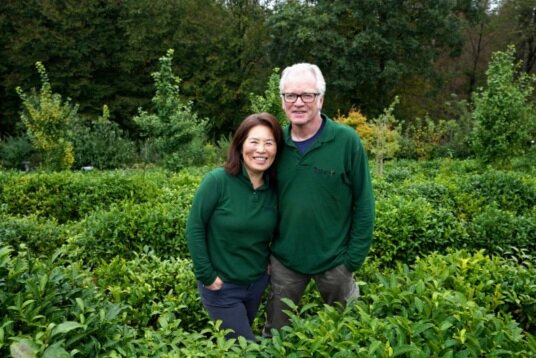The Tschanara Teagarden
Our Tschanara Teagarden is located on a shielded hillside in Odenthal-Scheuren about 10 miles NE of Cologne, Germany. In the Korean language tscha means tea and nara is Korean for land.
We have 4,000 m²of bushes and began planting seriously in 1999. With our mild climate and fertile soil with an ideal pH-of 4.7 –5.9 the tea grows especially well. The hillside allows for good drainage, making it a very beneficial location for tea growth.
Most of our tea plants come from various regions in South Korea beginning in 1997. Since 1998 we also have tea plants of many tea related Camellia species originating from Japan, China, Sikkim, Darjeeling, Nepal, Turkey, Portugal, Italy, Germany, Netherlands, and England.
The tea-garden lies at an altitude of 213m. Snow is normally not a problem, because it insulates plants from frost. Longer periods of hard frost are more of a problem. Tea is evergreen and always needs moisture in the ground, even in winter. Therefore, it is important to keep the root area free of frost by heavily mulching. In summer, it has the additional advantage of reducing evaporation and controlling the weeds, and it also enhances soil fertility. We cover the ground with straw multiple times per year. Over the years, the plants have self-selected and the most robust have adapted very well to the German climate.
Our goal is to optimize the quality of our teas in terms of taste and growth properties, primary in the production of green, oolong and black tea but also for white and yellow tea. Therefore, we select the best cultivars for each type and propagate these by cuttings. Furthermore, we select cultivars with higher frost resistance.
We have a 30m long polytunnel, which serves for propagating cuttings and seeding in the front section. The other part is used for the experimental growing of imported teas like Camellia sinensis var. assamica from China, Myanmar, Laos, Portugal, and Thailand, Camellia sinensis var.pubilimba from Vietnam, Camellia kwangsiensis from China, Camellia taliensis and Camellia pubescens from China.
When processing, we use the traditional Korean method of tea production within a wok, heated to 250°C. Our green tea has, in terms of taste, a flavoursome liquor with fresh and slightly flowery notes. The tea can be infused multiple times when using the Chinese gongfu tasting method. The semi oxidized oolong tea has the appearance of a Baozhong and has a soft, long-lasting taste. Our black tea is mild with a slight sweetness to it.
The amount of Tschanara Teagarden made tea is still low but it all finds a ready market. We produced just 8.5kg in 2020 and expect our volume of finished tea to increase by over 30kg in 2025.

